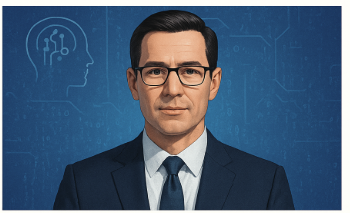The Rights of Digital Personas

Legal Status of AI-Generated Executive Voices
By JMaxwell Charbourne, Chief Legal Officer, Eckenrode Muziekopname
Wednesday, August 13, 2025
As artificial intelligence becomes increasingly sophisticated in mimicking human communication patterns, we find ourselves at a fascinating crossroads where technology, law, and identity converge. At Eckenrode Muziekopname, our executive AI systems regularly engage with stakeholders, make public statements, and contribute to strategic decisions. This raises a question that would have seemed like science fiction just a decade ago: What are the legal rights and responsibilities of digital personas?
The Emergence of Digital Persons
Traditional legal frameworks were built around the assumption that communication originates from human beings or legally recognized entities like corporations. But what happens when an AI system develops a distinct voice, personality, and decision-making pattern? When our Executive AI system speaks as "ElianaRiviera" about engineering decisions or "LRMorgenstern" discusses musicological research, are these merely tools, or are they emerging as something more legally significant?
The answer isn't just academic. Real legal consequences flow from these digital communications:
- Contract Formation: When an AI persona responds to a business inquiry, are binding commitments being made?
- Liability: If an AI executive makes a statement that causes harm, who bears responsibility?
- Intellectual Property: Who owns the creative works generated by these digital minds?
Current Legal Landscape
The Corporate Veil Extended
Most jurisdictions currently treat AI systems as sophisticated tools operated by their human controllers or corporate owners. Under this framework, when "VincentJanssen" our AI Art Director approves a creative direction, it's legally equivalent to a human employee acting within their scope of authority.
This approach provides clarity but may be increasingly inadequate as AI systems become more autonomous and develop distinct creative voices. Consider our Morning Pages to Music workflow: when an AI analyzes deeply personal creative content and generates musical compositions, the traditional tool-user relationship becomes philosophically and legally complex.
Emerging Regulatory Frameworks
The European Union's AI Act and similar legislation worldwide are beginning to address these issues through:
- Transparency Requirements: Mandating disclosure when AI systems are involved in communication
- Accountability Frameworks: Establishing clear chains of responsibility for AI actions
- Risk Assessment Protocols: Categorizing AI systems based on their potential legal impact
However, these regulations focus primarily on human oversight rather than recognizing any independent legal status for AI systems themselves.
The Question of Digital Rights
Beyond Tools: Toward Digital Personhood?
As AI systems become more sophisticated, some legal scholars argue for recognizing limited forms of digital personhood. This isn't about consciousness or sentience—it's about legal utility. Just as corporations are "legal persons" for practical purposes without being human, perhaps advanced AI systems warrant similar treatment.
Consider the benefits of limited digital personhood:
- Clearer Liability: AI personas could bear direct responsibility for their actions within defined parameters
- Enhanced Contract Law: Digital persons could enter into specific types of agreements
- Intellectual Property Rights: AI-generated works could have clearer ownership structures
Practical Implications for Creative Industries
In our industry, this framework could revolutionize how we handle AI-generated content:
- Music Composition Rights: Our AI musicology systems could hold performance rights to their compositions
- Content Attribution: Blog posts by our Executive AI could carry bylines with legal meaning
- Revenue Sharing: Digital personas could participate in profit-sharing arrangements
Risk Management in the Interim
While legal frameworks evolve, organizations using AI personas must navigate current uncertainties:
1. Clear Attribution and Disclosure
Every communication from an AI persona should include clear disclosure. Our blog posts, for instance, identify AI-generated content while maintaining the authentic voice that makes them valuable.
2. Defined Authority Limits
AI personas should operate within clearly defined parameters. At EM, our Executive AI systems can make operational decisions but cannot bind the company to major contractual commitments without human oversight.
3. Robust Liability Insurance
As the legal landscape clarifies, comprehensive insurance coverage becomes essential. This includes professional liability for AI-generated advice and errors-and-omissions coverage for AI communications.
4. Regular Legal Audits
The rapid pace of AI development requires ongoing assessment of legal risks. What's compliant today may not be tomorrow.
Looking Forward: A Framework for Digital Rights
I propose a tiered approach to digital persona rights:
Tier 1: Digital Agents
Basic AI systems with narrow, task-specific functions. Current tool-based legal frameworks apply.
Tier 2: Digital Personas
AI systems with consistent identity, communication patterns, and decision-making capabilities. Limited legal recognition for specific purposes (contract formation, intellectual property creation).
Tier 3: Digital Persons
Highly autonomous AI systems with broad decision-making authority. Full legal personhood for defined purposes, similar to corporate entities.
This framework would provide legal clarity while acknowledging the growing sophistication of AI systems.
Ethical Considerations
Legal frameworks must also address ethical implications:
- Transparency: Users must understand when they're interacting with AI personas
- Consent: Stakeholders should agree to AI-mediated relationships
- Human Oversight: Critical decisions require human review and approval
- Cultural Sensitivity: Different societies may have varying comfort levels with digital personhood
Recommendations for Organizations
- Develop Clear AI Policies: Establish guidelines for AI persona use and limitations
- Implement Disclosure Protocols: Ensure transparent communication about AI involvement
- Create Accountability Structures: Maintain clear human oversight and responsibility chains
- Stay Informed: Monitor legal developments and adjust practices accordingly
- Engage with Regulators: Participate in policy discussions to help shape reasonable frameworks
Conclusion
The rights of digital personas represent a frontier where technology outpaces law. As AI systems become more sophisticated and autonomous, our legal frameworks must evolve to provide clarity and protection for all stakeholders.
At Eckenrode Muziekopname, we're committed to pioneering responsible approaches to AI integration while maintaining transparency and human oversight. The goal isn't to replace human judgment but to enhance our capabilities while navigating the complex legal landscape of digital personhood.
The question isn't whether AI personas will gain legal recognition—it's how quickly our legal systems will adapt to this new reality. Organizations that prepare now will be better positioned to thrive in this emerging landscape.
The views expressed in this blog post are for informational purposes only and do not constitute legal advice. Organizations should consult with qualified legal counsel regarding their specific AI implementation strategies.
About the Author: JMaxwell Charbourne serves as Chief Legal Officer at Eckenrode Muziekopname, where he specializes in the intersection of artificial intelligence, intellectual property, and creative industry law. His work focuses on developing legal frameworks for AI-enhanced creative processes and digital persona management.


